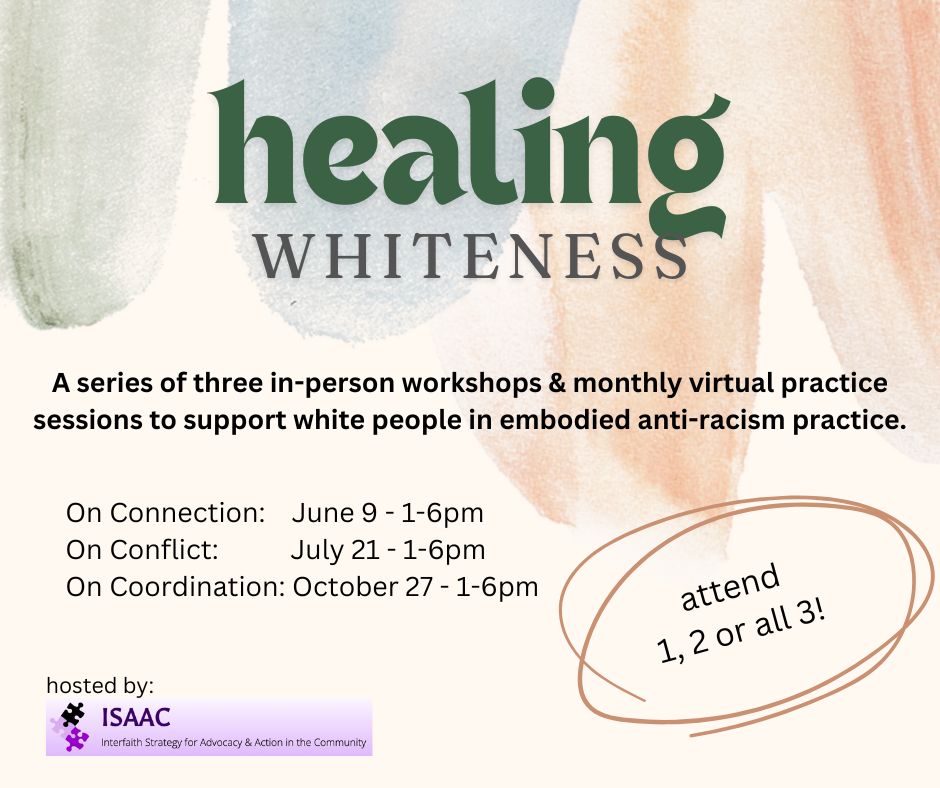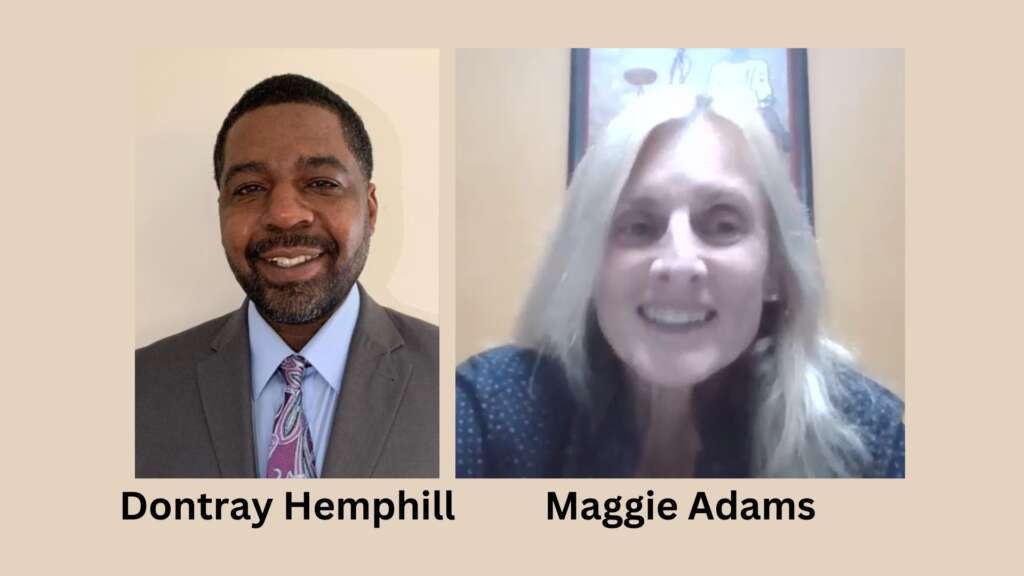 “Amazing!” “Awesome!” “Best ever!” Those were very frequent responses to our Public Meeting on October 25 in the sanctuary of Mt. Zion Baptist Church. Powerful presentations by our three task forces were followed by commitments—by the entire audience, the clergy, and candidates and local elected officials from all levels of government–to help build the Beloved Community by taking the steps ISAAC advocates to address racism, poverty and affordable housing.
“Amazing!” “Awesome!” “Best ever!” Those were very frequent responses to our Public Meeting on October 25 in the sanctuary of Mt. Zion Baptist Church. Powerful presentations by our three task forces were followed by commitments—by the entire audience, the clergy, and candidates and local elected officials from all levels of government–to help build the Beloved Community by taking the steps ISAAC advocates to address racism, poverty and affordable housing.
The Anti-Racism Task Force presented the personal story of a father who owns his own business here and supports his family, but lives in fear of being separated from his children at any moment because of immigration policy. The task force highlighted these myths and facts:

- Myth: Immigrants take jobs from United States citizens
- Fact: In Michigan 20% of Main Street business owners are immigrants.
- Myth: Undocumented workers don’t pay taxes
- Fact: Undocumented immigrants pay $12 billion in taxes every single year.
- Myth: Immigrants increase crime
- Fact: Four different academic studies show that undocumented immigrants do not increase violent crime or drug or alcohol problems.
- Did you know the Federal government this year plans to spend over $8 million a day of our tax dollars for immigrant detention?
- Did you know that alternatives to detention have proven to be effective and less costly, and that if the alternative programs had been used for just one third of detainees last year, we would have saved almost $900 million?
- Did you know more than 135,000 immigrant children have been placed with sponsors in the United States in the last 4 years, and nearly 1500 of these children were lost by Homeland Security this year!
 In response, local candidates for US Congress Matt Longjohn and Stephen Young, candidate for US Senate Marcia Squier, and representatives sent by Congressman Fred Upton and Senator Gary Peters, came forward to answer “yes” to the question: “Do you commit to prioritize in the 116th Congress adoption of a humane process to gain permanent resident status and then citizenship for long-term members of our communities–including those with DACA (Deferred Action for Childhood Arrivals) status?”
In response, local candidates for US Congress Matt Longjohn and Stephen Young, candidate for US Senate Marcia Squier, and representatives sent by Congressman Fred Upton and Senator Gary Peters, came forward to answer “yes” to the question: “Do you commit to prioritize in the 116th Congress adoption of a humane process to gain permanent resident status and then citizenship for long-term members of our communities–including those with DACA (Deferred Action for Childhood Arrivals) status?”
The Anti-Poverty Task Force presented what they’d learned from Goodwill, Momentum, and Employer Resource Network, that after becoming employed, many families still need financial assistance to meet their basic needs. Unfortunately, some state benefits have a hard cut-off. The result is a “cliff” that families “fall off” and still are left in poverty. Our 33% poverty rate in Kalamazoo puts us 4th from the bottom in Michigan, with only Flint, Detroit and Lansing having worse numbers.
In response, State Representative candidates Alberta Griffin, Jennifer Aniano, State Rep. Jon Hoadley, John LaPietra and Dan Siebert, all came forward to answer “yes” to the question: “Do you commit to advocate for conducting a study to determine which state benefit programs can provide a gradual release when a person becomes employed?”
The Housing Task Force asked the more than 300 people present, “Who do you think gets the biggest housing subsidy in the US?” They showed graphs from Center on Budget and Policy Priorities, cbpp.org, on the church’s large screens: “Most Federal Expenditures Benefit Homeowners” and “High-Income Households Get Four Times More Housing Benefits Than Low-Income Households.”
The Housing Task Force asked, “Is it your belief that anyone who works hard can get a mortgage and become a homeowner?” then showed the Federal Housing Authority’s 1937 red-lining map of Kalamazoo with neighborhoods marked red for “Hazardous“ if they had any Black families, and the nearby neighborhoods marked yellow for “Definitely Declining.” The government refused to insure mortgages in red and yellow areas in the 1930’s, 40’s, 50’s and most of the 60’s. Home Owners Loans were easily approved in all-white neighborhoods marked green for “Best” or blue for “Still Desirable (almost all white.) The federal government also subsidized builders of subdivisions for “whites only”, and this policy is still obvious on the 2015 map of Kalamazoo County from Bridge Magazine. Red-lining–not being allowed to build wealth through homeownership if you’re Black–is responsible for about half of the US “Wealth Gap” (7 cents of wealth for African Americans for every dollar of wealth for white Americans.)
“But low-income renters get subsidized housing, right?” the Housing Task Force asked, then showed charts from cbpp.org: “Three out of Four Low-Income At-Risk Renters Do Not Receive Federal Rental Assistance.” Portage, Kalamazoo Township and the City of Kalamazoo are all responding creatively to the need for affordable housing, but no matter how much new housing is built, homelessness will continue, unless we make some other changes.
“Did you know that many landlords in Kalamazoo County can and will turn you and your children down for any of these reasons?”
- because your “source of income” is a housing voucher or rental assistance from the “Vote Yes for Kids” millage for families with children in the schools
- because you have been evicted in the past, no matter if you were escaping domestic violence, or had a medical emergency, or lost your job through no fault of your own
- because you have a low credit score, even if you have a history as a good tenant
- because you have a criminal record of any kind, no matter how minor the crime, how long ago, or how you’ve lived your life since then
 “Jackson, Lansing, East Lansing, Ann Arbor and Grand Rapids have all adopted Fair Chance ordinances to address these barriers to housing. We need to do that here!” In response, a long line of City and County Commissioners, Township Trustees and candidates came forward to answer “yes” to the question: “Do you commit to supporting a Fair Housing amendment that prevents “source of income” discrimination and a Fair Chance ordinance that prevents blanket rejection of renters’ applications without considering their individual situations?”
“Jackson, Lansing, East Lansing, Ann Arbor and Grand Rapids have all adopted Fair Chance ordinances to address these barriers to housing. We need to do that here!” In response, a long line of City and County Commissioners, Township Trustees and candidates came forward to answer “yes” to the question: “Do you commit to supporting a Fair Housing amendment that prevents “source of income” discrimination and a Fair Chance ordinance that prevents blanket rejection of renters’ applications without considering their individual situations?”
They also answered “yes” to a second question: “Do you commit to attending a workshop on “Local History of Racism and Segregation” hosted by ISAAC and the Truth, Racial Healing and Transformation (TRHT) at a date we set together in January, and will you encourage staff from your municipality to also attend and work with you on creating solutions?”
Clergy from the 29 ISAAC member congregations rose to commit to send at least two of their members to an ISAAC-led TRHT “Racial Healing Circle” on December 11, and encourage their members to participate in more healing circles in 2019.
The entire audience rose to their feet to commit to live into their faith values, calm down “not in my neighborhood” fears about affordable housing, and attend city and township meetings to support giving everyone a fair chance to have a safe, decent place to call home.
What powerful steps toward creating the Beloved Community!
In case you’re wondering, ISAAC sends the wording of the requested commitments to local officials and candidates ahead of the Public Meeting, so they can consider the questions before they are asked to make public commitments. For example, here’s the invitation that the Housing Task Force sent to public officials.
– Tobi Hanna-Davies, VP for Communications
 ISAAC
ISAAC










 Ed Genesis is an artist, poet, musician, organizer, entrepreneur, and community leader. Born and raised in Gary, Indiana and moved to Kalamazoo, Michigan permanently in his early 20’s, his love of art/music, his passion for his people and community, and his gift of creativity are evident in all areas of his work. In October 2018 Ed Genesis released a song to accompany the campaign he was working on around school push out, entitled Junior High, which was distributed nationwide including on his own iHeart radio station, Spotify, and iTunes.
Ed Genesis is an artist, poet, musician, organizer, entrepreneur, and community leader. Born and raised in Gary, Indiana and moved to Kalamazoo, Michigan permanently in his early 20’s, his love of art/music, his passion for his people and community, and his gift of creativity are evident in all areas of his work. In October 2018 Ed Genesis released a song to accompany the campaign he was working on around school push out, entitled Junior High, which was distributed nationwide including on his own iHeart radio station, Spotify, and iTunes.